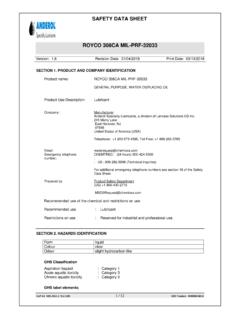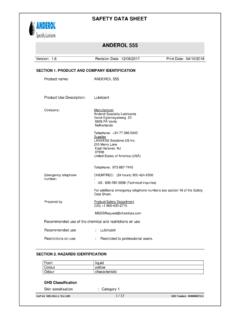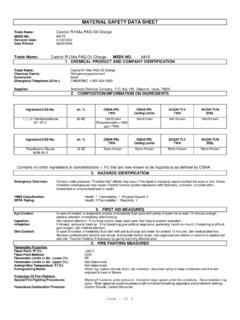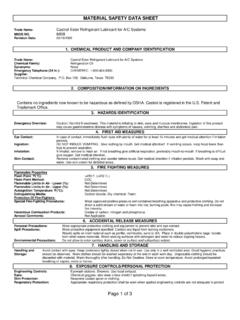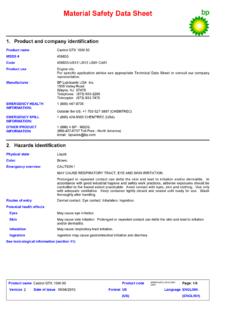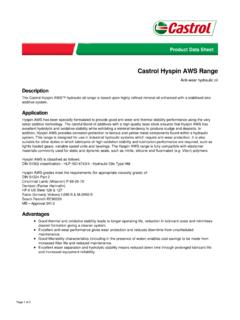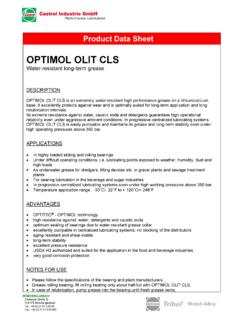Transcription of SAFETY DATA SHEET - QC Lubricants
1 Aero 40 SAFETY data SHEETP roduct nameSection 1. IdentificationSDS #Historic SDS #:27027 Product useHydraulic fluidFor specific application advice see appropriate Technical data SHEET or consult our company Lubricants USA Valley RoadWayne, NJ 07470 Telephone: +1-888-CASTROLP roduct Information: +1-877-641-1600 EMERGENCY HEALTH INFORMATION:+1-800-447-8735 EMERGENCY SPILL INFORMATION:+1-800-424-9300 (CHEMTREC USA)+1-703-527-3887 (CHEMTREC outside the US)454514 Relevant identified uses of the substance or mixture and uses advised againstSection 2. Hazards identificationASPIRATION HAZARD - Category 1 Classification of the substance or mixtureSignal wordDangerHazard statementsMay be fatal if swallowed and enters pictogramsPrecautionary statementsPreventionNot SWALLOWED: Immediately call a POISON CENTER or physician. Do NOT induce locked of contents and container in accordance with all local, regional, national and international label elementsOSHA/HCS statusThis material is considered hazardous by the OSHA Hazard Communication Standard (29 CFR ).
2 Hazards not otherwise classifiedDefatting to the : High Pressure ApplicationsInjections through the skin resulting from contact with the product at high pressure constitute a major medical 'Notes to physician' under First-Aid Measures, Section 4 of this SAFETY data of issue 10/26 : 1/10 Aero 40 ENGLISH(ENGLISH)Product nameProduct (US)Section 3. Composition/information on ingredientsThere are no additional ingredients present which, within the current knowledge of the supplier and in the concentrations applicable, are classified as hazardous to health and hence require reporting in this exposure limits, if available, are listed in Section concentration shown as a range is to protect confidentiality or is due to batch refined mineral oil and additivesDistillates (petroleum), hydrotreated, light naphthenic64742-53-6 50 - 75 Distillates (petroleum), hydrotreated light paraffinic64742-55-8 10 - 25 Distillates (Petroleum) hydrotreated light64742-47-8 10 - 25 Distillates (petroleum), hydrotreated, light naphthenic64742-53-6 10 Distillates (Petroleum) hydrotreated light64742-47-8 10 Zinc dialkyl dithiophosphate68457-79-4<3 Ingredient nameCAS number%Do not induce vomiting.
3 Never give anything by mouth to an unconscious person. If unconscious, place in recovery position and get medical attention hazard if swallowed. Can enter lungs and cause damage. Get medical attention case of contact, immediately flush eyes with plenty of water for at least 15 should be held away from the eyeball to ensure thorough rinsing. Check for and remove any contact lenses. Get medical inhaled, remove to fresh air. Get medical attention if symptoms 4. First aid measuresEye contactInhalationIngestionProtection of first-aidersNo action shall be taken involving any personal risk or without suitable training. It may be dangerous to the person providing aid to give mouth-to-mouth to physicianTreatment should in general be symptomatic and directed to relieving any can be aspirated on swallowing or following regurgitation of stomach contents,and can cause severe and potentially fatal chemical pneumonitis, which will require urgent treatment.
4 Because of the risk of aspiration, induction of vomiting and gastric lavage should be avoided. Gastric lavage should be undertaken only after endotracheal intubation. Monitor for cardiac dysrhythmias. Note: High Pressure ApplicationsInjections through the skin resulting from contact with the product at high pressure constitute a major medical emergency. Injuries may not appear serious at first but within a few hours tissue becomes swollen, discolored and extremely painful with extensive subcutaneous exploration should be undertaken without delay. Thorough and extensive debridement of the wound and underlying tissue is necessary to minimize tissue loss and prevent or limit permanent damage. Note that high pressure may force the product considerable distances along tissue of necessary first aid measuresSpecific treatmentsNo specific of immediate medical attention and special treatment needed, if necessarySee Section 11 for more detailed information on health effects and important symptoms/effects, acute and delayedSkin contactWash skin thoroughly with soap and water or use recognized skin cleanser.
5 Remove contaminated clothing and shoes. Wash clothing before reuse. Clean shoes thoroughly before reuse. Get medical attention if symptoms of issue 10/26 : 2/10 Aero 40 ENGLISH(ENGLISH)Product nameProduct (US)Section 5. Fire-fighting measuresPromptly isolate the scene by removing all persons from the vicinity of the incident if there is a fire. No action shall be taken involving any personal risk or without suitable combustion productsSpecific hazards arising from the chemicalCombustion products may include the following:phosphorus oxidesmetal oxide/oxidescarbon oxides (CO, CO2) (carbon monoxide, carbon dioxide)sulfur oxides (SO, SO2 etc.)In a fire or if heated, a pressure increase will occur and the container may should wear positive pressure self-contained breathing apparatus (SCBA)and full turnout protective equipment for fire-fightersIn case of fire, use foam, dry chemical or carbon dioxide extinguisher or mediaDo not use water extinguishing mediaUnsuitable extinguishing mediaSpecial protective actions for fire-fightersSection 6.
6 Accidental release measuresEnvironmental precautionsPersonal precautions, protective equipment and emergency proceduresStop leak if without risk. Move containers from spill area. Approach release from upwind. Prevent entry into sewers, water courses, basements or confined and collect spillage with non-combustible, absorbent material sand, earth,vermiculite or diatomaceous earth and place in container for disposal according to local regulations. Contaminated absorbent material may pose the same hazard as the spilled product. Dispose of via a licensed waste disposal action shall be taken involving any personal risk or without suitable surrounding areas. Keep unnecessary and unprotected personnel from entering. Do not touch or walk through spilled material. Avoid breathing vapor or adequate ventilation. Put on appropriate personal protective equipment. Floors may be slippery; use care to avoid falling.
7 Contact emergency dispersal of spilled material and runoff and contact with soil, waterways, drains and sewers. Inform the relevant authorities if the product has caused environmental pollution (sewers, waterways, soil or air).Large spillStop leak if without risk. Move containers from spill area. Absorb with an inert material and place in an appropriate waste disposal container. Dispose of via a licensed waste disposal spillMethods and materials for containment and cleaning upFor non-emergency personnelFor emergency respondersEntry into a confined space or poorly ventilated area contaminated with vapor, mist or fume is extremely hazardous without the correct respiratory protective equipment and a safe system of work. Wear self-contained breathing apparatus. Wear a suitable chemical protective suit. Chemical resistant boots. See also the information in "For non-emergency personnel".Section 7.
8 Handling and storageProtective measuresPut on appropriate personal protective equipment (see Section 8). Avoid breathing vapor or mist. Avoid contact with eyes, skin and clothing. Empty containers retain product residue and can be hazardous. Keep in the original container or an approved alternative made from a compatible material, kept tightly closed when not in use. Do not reuse container. Do not swallow. Aspiration hazard if swallowed. Can enter lungs and cause damage. Never siphon by for safe handlingDate of issue 10/26 : 3/10 Aero 40 ENGLISH(ENGLISH)Product nameProduct (US)Section 7. Handling and storageAdvice on general occupational hygieneConditions for safe storage,including any incompatibilitiesEating, drinking and smoking should be prohibited in areas where this material is handled, stored and processed. Wash thoroughly after handling. Remove contaminated clothing and protective equipment before entering eating areas.
9 See also Section 8 for additional information on hygiene in accordance with local regulations. Store in original container protected from direct sunlight in a dry, cool and well-ventilated area, away from incompatible materials (see Section 10) and food and drink. Store locked up. Keep container tightly closed and sealed until ready for use. Store and use only in equipment/containers designed for use with this product. Containers that have been opened must be carefully resealed and kept upright to prevent leakage. Do not store in unlabeled containers. Use appropriate containment to avoid environmental compounds in this material may decompose when heated to release hydrogen sulfide gas which may accumulate to potentially lethal concentrations in enclosed air spaces. Vapor concentrations of hydrogen sulfide above 50 ppm, or prolonged exposure at lower concentrations, may saturate human odor perceptions so that the smell of gas may not be apparent.
10 Exposure to concentrations of hydrogen sulfide vapor above 500 ppm may cause rapid death. Do not rely on the sense of smell to detect hydrogen (petroleum), hydrotreated, light naphthenicACGIH TLV (United States). TWA: 5 mg/m 8 hours. Issued/Revised:11/2009 Form: Inhalable fractionOSHA PEL (United States). TWA: 5 mg/m 8 hours. Issued/Revised:6/1993 Distillates (petroleum), hydrotreated light paraffinicACGIH TLV (United States). TWA: 5 mg/m 8 hours. Issued/Revised:11/2009 Form: Inhalable fraction TWA: 5 mg/m 8 hours. Form: Mineral oil,mistOSHA PEL (United States). TWA: 5 mg/m 8 hours. Issued/Revised:6/1993 Distillates (Petroleum) hydrotreated lightACGIH TLV (United States). Absorbed through skin. TWA: 200 mg/m , (as total hydrocarbon vapor) 8 hours. Issued/Revised: 1/2003 Distillates (petroleum), hydrotreated, light naphthenicACGIH TLV (United States). TWA: 5 mg/m 8 hours. Issued/Revised:11/2009 Form: Inhalable fraction TWA: 5 mg/m 8 hours.
